Unit 4 History and Traditions Discovering Useful Structures 课件(共32张PPT)-人教版(2019)必修第二册
文档属性
| 名称 | Unit 4 History and Traditions Discovering Useful Structures 课件(共32张PPT)-人教版(2019)必修第二册 | 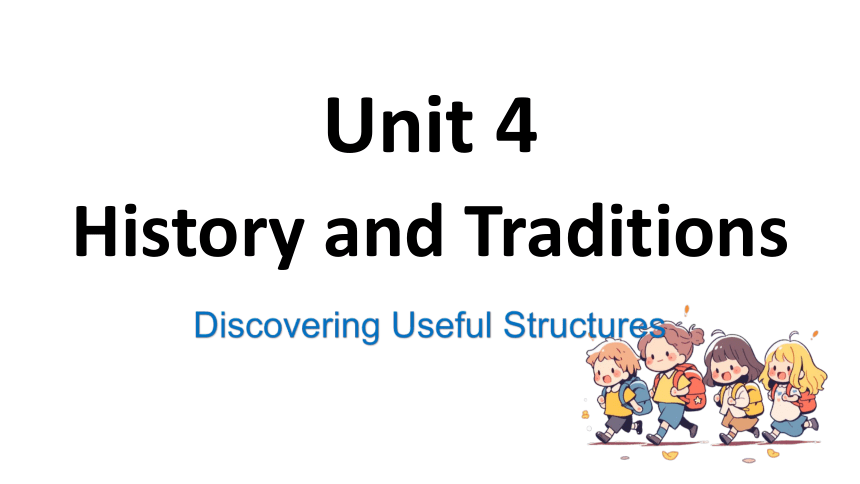 | |
| 格式 | pptx | ||
| 文件大小 | 2.1MB | ||
| 资源类型 | 教案 | ||
| 版本资源 | 人教版(2019) | ||
| 科目 | 英语 | ||
| 更新时间 | 2025-07-29 16:46:17 | ||
图片预览

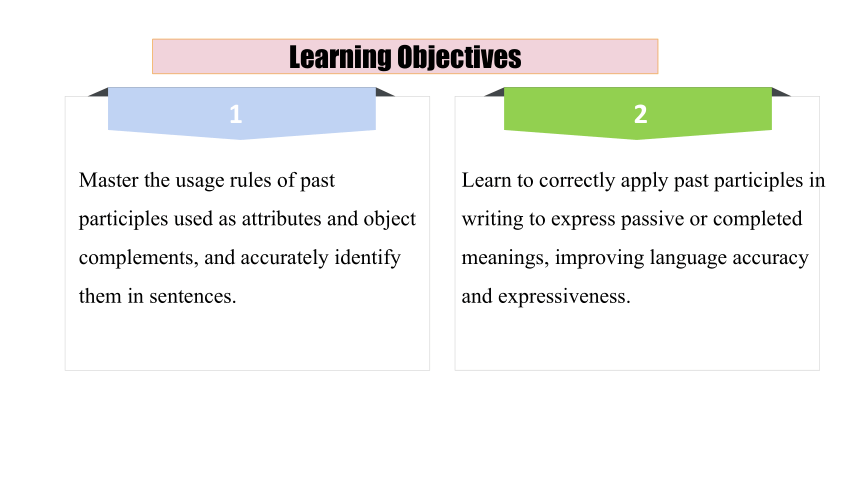
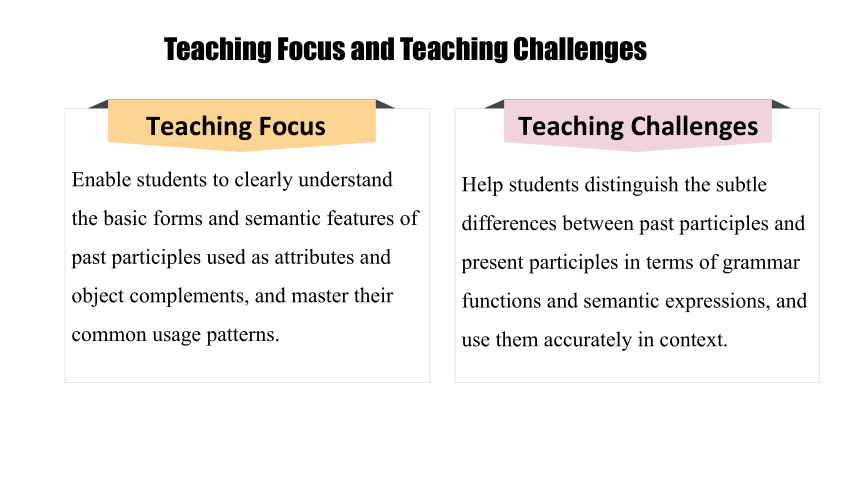
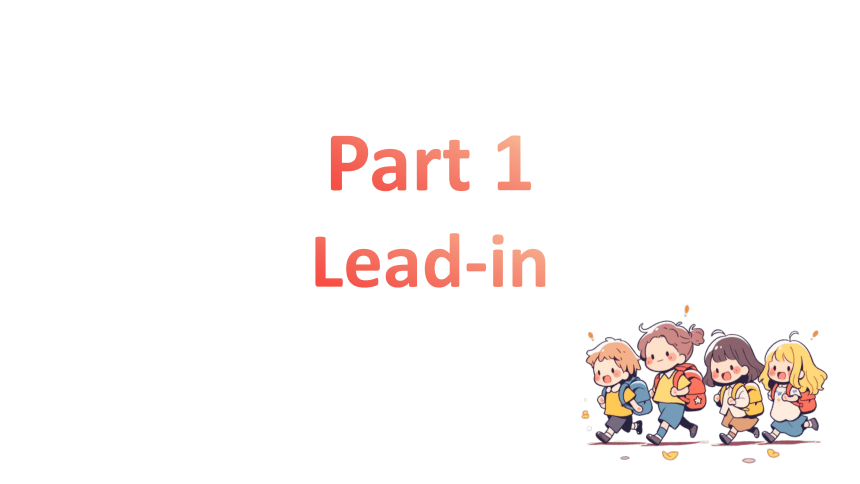
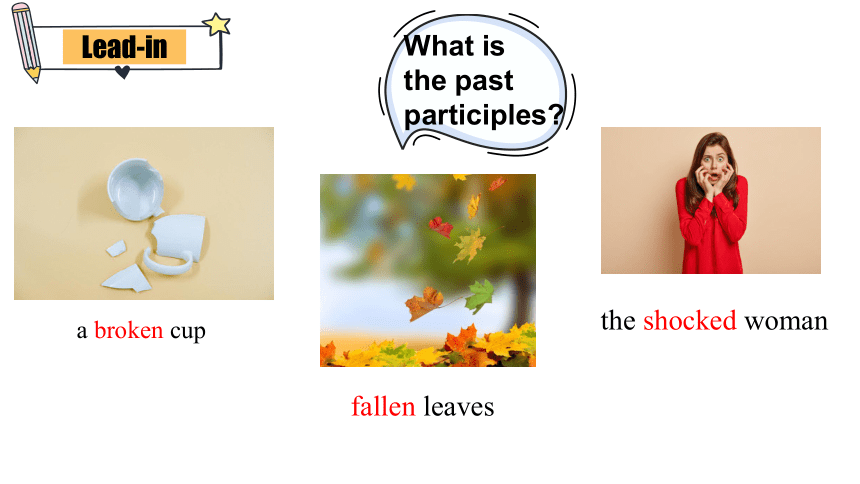

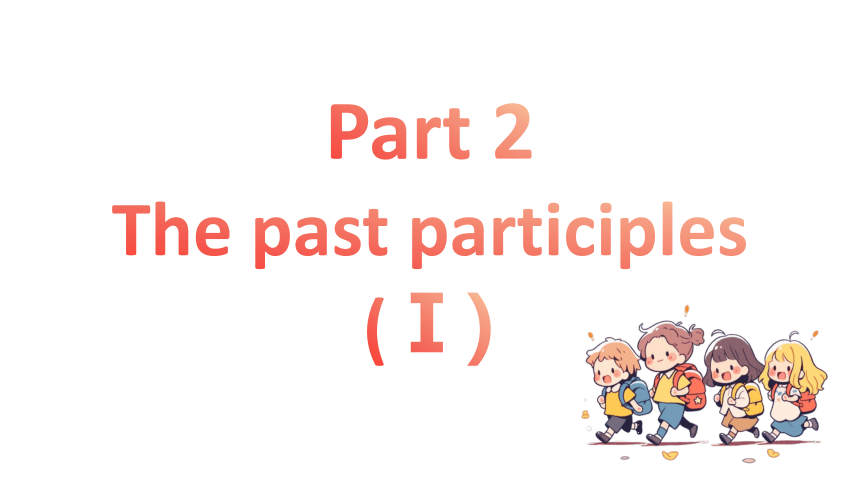
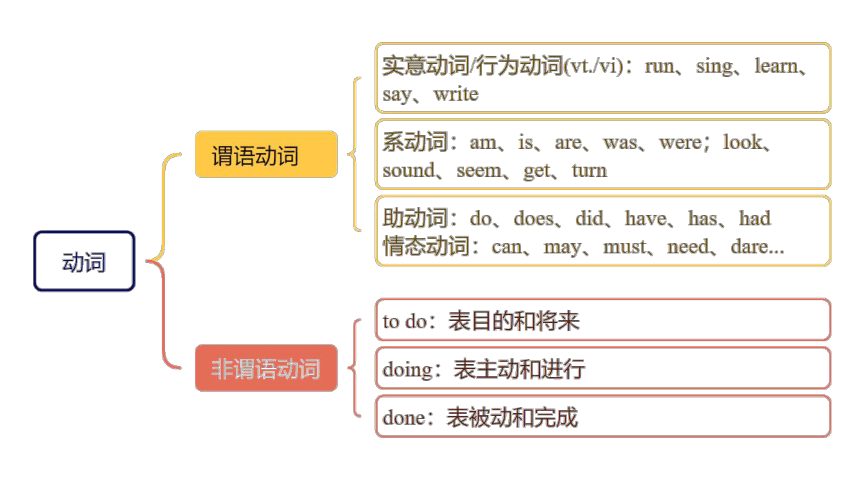
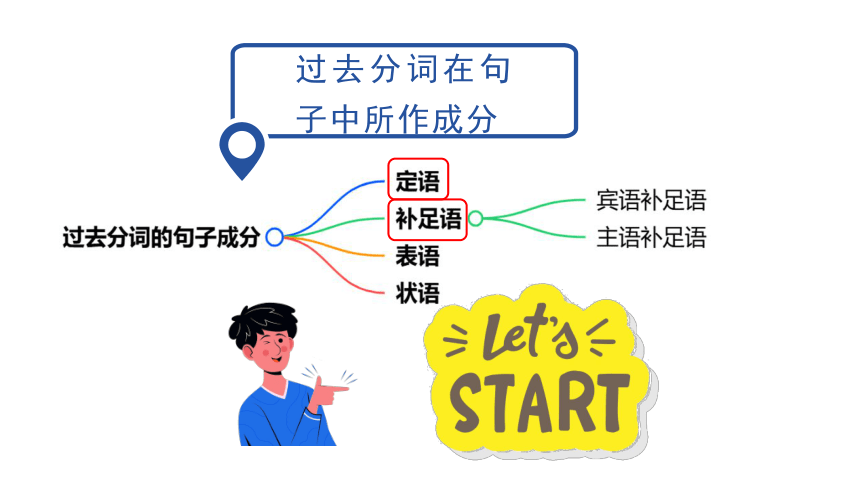
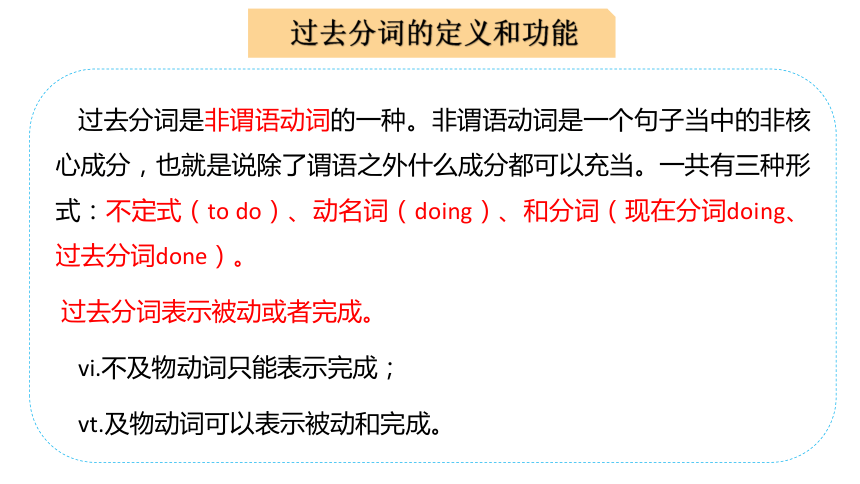
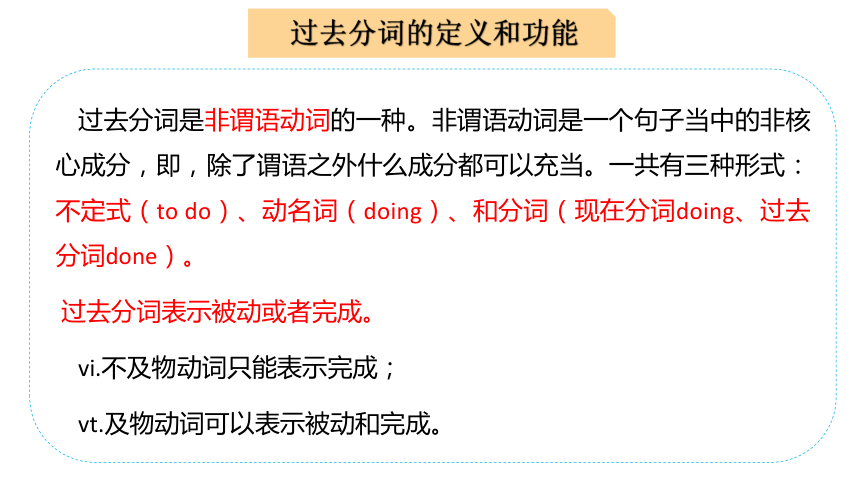
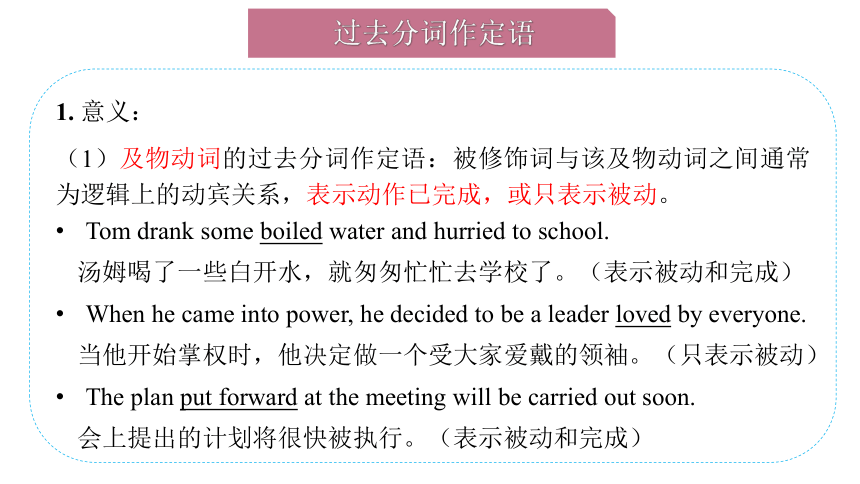
文档简介
(共32张PPT)
Unit 4
History and Traditions
Discovering Useful Structures
1
Master the usage rules of past participles used as attributes and object complements, and accurately identify them in sentences.
2
Learn to correctly apply past participles in writing to express passive or completed meanings, improving language accuracy and expressiveness.
Learning Objectives
Teaching Focus
Enable students to clearly understand the basic forms and semantic features of past participles used as attributes and object complements, and master their common usage patterns.
Teaching Challenges
Help students distinguish the subtle differences between past participles and present participles in terms of grammar functions and semantic expressions, and use them accurately in context.
Teaching Focus and Teaching Challenges
Part 1
Lead-in
Lead-in
a broken cup
fallen leaves
the shocked woman
What is the past participles
Look at the sentences and underline the past participles. In pairs, discuss their functions. Then find more sentences with the -ed form in the text.
1. Most people just use the shortened name: “the United Kingdom” or “the UK”.
2. They use the same flag, known as the Union Jack, ...
3. They had castles built all around England, ...
as the attribute
as the attribute
as the attribute
as the object complement
Part 2
The past participles
(Ⅰ)
过去分词在句子中所作成分
过去分词的定义和功能
过去分词是非谓语动词的一种。非谓语动词是一个句子当中的非核心成分,也就是说除了谓语之外什么成分都可以充当。一共有三种形式:不定式(to do)、动名词(doing)、和分词(现在分词doing、过去分词done)。
过去分词表示被动或者完成。
vi.不及物动词只能表示完成;
vt.及物动词可以表示被动和完成。
过去分词的定义和功能
过去分词是非谓语动词的一种。非谓语动词是一个句子当中的非核心成分,即,除了谓语之外什么成分都可以充当。一共有三种形式:不定式(to do)、动名词(doing)、和分词(现在分词doing、过去分词done)。
过去分词表示被动或者完成。
vi.不及物动词只能表示完成;
vt.及物动词可以表示被动和完成。
过去分词作定语
1. 意义:
(1)及物动词的过去分词作定语:被修饰词与该及物动词之间通常为逻辑上的动宾关系,表示动作已完成,或只表示被动。
Tom drank some boiled water and hurried to school.
汤姆喝了一些白开水,就匆匆忙忙去学校了。(表示被动和完成)
When he came into power, he decided to be a leader loved by everyone.
当他开始掌权时,他决定做一个受大家爱戴的领袖。(只表示被动)
The plan put forward at the meeting will be carried out soon.
会上提出的计划将很快被执行。(表示被动和完成)
过去分词作定语
2. 位置:
(1)单个的过去分词作定语一般放在被修饰的名词之前,但 left只作后置定语。
The broken vase has been thrown outside.
那个碎了的花瓶被扔到外面去了。
The books left are for my students.
剩下的书是给我的学生的。
注意:单个的过去分词修饰something,everything,anything,nothing,nobody 等复合不定代词或those等指示代词时,要放在这些词的后面。
过去分词作定语
(2)过去分词短语作定语要放在被修饰的名词后,其作用相当于一个定语从句。
I borrowed a book written by Mark Twain from the library. =
I borrowed a book which/that was written by Mark Twain from the library.
我从图书馆里借了一本马克·吐温写的书。
This will be the best novel of its kind ever written. =
This will be the best novel of its kind that has ever been written.
这将是这类小说中写得最好的。
过去分词作定语
3. 过去分词作定语与现在分词作定语的区别:
过去分词与所修饰的名词之间存在动宾关系,表示一个已完成的动作。现在分词与所修饰的名词之间存在主谓关系,它表示一个正在进行的动作。
This is a letter written in black ink. 这是一封用黑墨水写的信。
All the books borrowed from the library must be returned by next Saturday. 所有从图书馆借的书都得在下星期六前归还。
The man planting trees in front of the building is our teacher.
在大楼前面植树的那个人是我们的老师。
过去分词作宾补
1. 意义
过去分词作宾语补足语时,主要用于补充说明宾语所承受的动作或所处的状态,通常出现在“主语+谓语动词+宾语+过去分词”的结构中。这种用法强调宾语是被动接受某个动作或已经处于某种完成状态,常见的谓语动词包括感官动词(如see, hear, feel)、使役动词(如have, get, make)以及表示意愿的动词(如want, find)。
I heard my name called.
过去分词“called”作宾补,说明宾语“my name”承受了“被叫”的动作
过去分词作宾补
2. 用法
过去分词(短语)作宾补,用于“主语+谓语+宾语+宾补“句式,说明宾语的性质或状态,构成过去分词的动词与宾语之间为逻辑上的动宾关系。能够接过去分词作宾补的动词主要有如下几类:
(1)表示感觉或心理状态的动词,如see,hear,feel,watch,notice,
think,find等后面作宾语补足语。
I heard the English song sung twice in the next room.
我听到隔壁房间里唱了两遍这首英文歌。
When he arrived, he found all the work finished.
当他到达时,他发现所有的工作都完成了。
过去分词作宾补
(2)表示使役的动词:get, let, make, have, keep等后面作宾语补足语。
I have my hair cut twice a month.
我每个月剪两次头发。 (让别人做)
Mary had her bike stolen the other day.
玛丽的自行车在前几天被人偷了。(遭遇不幸)
Their aim was to get production started as soon as possible.
他们的目的是尽快开始生产。(主语自己也可能参加)
They kept the door locked for a long time.
他们把门锁了好长一段时间。(处于某种状态)
过去分词作宾补
(3)表示“希望”“愿望”等意义的动词,如want,wish,like,expect,order等后面作宾语补足语。
The manager ordered the work finished at the end of this week.
经理要求在本周末完成这项工作。
The teacher doesn’t wish such questions (to be) discussed in class.
老师不希望在课堂上讨论这样的问题。
He wants his composition read by every classmate.
他想班里每个同学都读一读自己的作文。
过去分词作宾补
注意:两个特殊结构
◆ 作介词的补足语,主要用于“with/without+复合结构”中。
With the problem settled, he felt quite happy.
随着问题的解决,他感到相当开心。
◆ 在“have +宾语 +过去分词”结构中,过去分词作宾补,也可用 get。有以下几种含义:
① 意为主语“请别人做某事”。
He wants to have his eyes examined tomorrow.
他想明天去检查眼睛。
过去分词作宾补
② 意为主语“遭遇、遭受某一不愉快的事情”。
Be careful, or you’ll have your hands hurt.
小心点,不然会伤到手。
③ 意为“使完成某事”,事情既可以是别人做完,也可以由主语参与完成。
He had the walls painted this morning.
他今早将墙壁粉刷好了。
过去分词作宾补
3. 过去分词、现在分词和动词不定式作宾补的区别
过去分词作宾补:宾语和构成宾补的动词之间存在逻辑上的动宾关系; 表示被动、完成的动作。
现在分词作宾补:宾语和构成宾补的动词之间存在逻辑上的主谓关系;表示主动、正在进行的动作。
动词不定式作宾补(感官动词hear,see,notice等可以接省略to的动词不定式作宾补):宾语和构成宾补的动词之间存在逻辑上的主谓关系;表示主动动作发生的全过程。
Summary
过去分词作定语
位置:单个分词前置,短语后置。
含义:表被动或完成,部分已形容词化。
过去分词作宾补
结构:动词 + 宾语 + 过去分词,与宾语构成被动关系。
常见动词:使役动词(have/get)、感官动词(see/find)、保持类动词(keep/leave)。
核心区别:定语修饰名词,宾补补充说明宾语状态。
Part 3
Exercise
Complete the phrases in the right column by using the past participles in the left column. Compare the meaning of each pair of phrases. Then make sentences with the phrases.
Past Participles as the Attribute (1)
tired visitors
a well-organised trip
beautifully dressed stars
Past Participles as the Attribute (2)
visitors ________ of the long wait/...
a trip _________ well by my workplace/...
stars ________ beautifully at the event/...
tired
organised
dressed
1. 单个的过去分词作定语时,一般前置;过去分词短语作定语时,则后置。
2. 过去分词是像well-organised这样的复合形式,或前面有副词修饰时,一般放在被修饰词前面作前置定语。类似的还有:state-owned company、hand-made gifts、beautifully written characters等。
Read the sentences and underline the -ed form as the object complement.
1. Judy and I had our car parked in an underground car park near Trafalgar Square, where we could get our car battery charged.
2. When we finally reached the service desk to ask for audio guides, we heard it announced that there were no audio guides left.
3. We found ourselves very surprised by the large number of visitors and the amount of noise at the entrance of the National Gallery.
4. Judy had her eyes fixed on Van Gogh’s Sunflowers. It was hard to approach the painting as there were so many people around.
5. She had a copy of the painting boxed to ensure that it was delivered safely.
When the past participle is used as the object complement, it is often formed with the “have/get/feel/find/hear... + object + -ed form”.
Rewrite the sentences with past participles as the attribute and then see whether you can write a little story with them.
1. Loch Ness (尼斯湖, 苏格兰) was surrounded by beautiful natural landscape, which made it look amazing.
2. Carl and his friends stayed with a generous family who offered them bread with butter and honey that was homemade.
= Loch Ness surrounded by beautiful natural landscape looks amazing.
= Carl and his friends stayed with a generous family who offered homemade bread with butter and honey.
Rewrite the sentences with past participles as the attribute and then see whether you can write a little story with them.
3. The family’s ancestors once attended to soldiers who were wounded in the First World War.
4. The young people were attracted by the legend of Loch Ness (尼斯湖的传奇). They watched over the lake with their cameras and binoculars (双筒望远镜), which were positoned (安放) on the hill.
= The family’s ancestors once attended to wounded soldiers in the First World War.
= The young people attracted by the legend of Loch Ness watched over the lake with their cameras and binoculars positioned on the hill.
It can help to build a community with a __________(share)future for mankind," he said.
In 1985, urban men and women in more than three quarters of the countries __________ (study) had higher BMIs than men and women in rural areas.
A study __________ (conduct) in Youngstown, Ohio for example, discovered that greener areas of the city experienced less crime.
Lighting accounts for about 7% of the total electricity__________(consume) in the US.
Will you please make yourself __________(understand) to us, please
understood
consumed
conducted
shared
studied
1.The books ________ (buy) yesterday are of high quality.
2.He found his hometown greatly ________ (change).
3.The computer center, ________ (open) last year, is very popular among the students.
4.I wonder how many times I have to come here and get my false teeth ________ (fix).
5.They reduced the number of animals ________ (use) in experiments.
6.You should understand the traffic rule by now. You’ve had it ________ (explain) often enough.
bought
changed
opened
fixed
used
explained
Homework
1. Summarise what we have learnt in this lesson;
2. Prepare for the next lesson
See you next time!
Unit 4
History and Traditions
Discovering Useful Structures
1
Master the usage rules of past participles used as attributes and object complements, and accurately identify them in sentences.
2
Learn to correctly apply past participles in writing to express passive or completed meanings, improving language accuracy and expressiveness.
Learning Objectives
Teaching Focus
Enable students to clearly understand the basic forms and semantic features of past participles used as attributes and object complements, and master their common usage patterns.
Teaching Challenges
Help students distinguish the subtle differences between past participles and present participles in terms of grammar functions and semantic expressions, and use them accurately in context.
Teaching Focus and Teaching Challenges
Part 1
Lead-in
Lead-in
a broken cup
fallen leaves
the shocked woman
What is the past participles
Look at the sentences and underline the past participles. In pairs, discuss their functions. Then find more sentences with the -ed form in the text.
1. Most people just use the shortened name: “the United Kingdom” or “the UK”.
2. They use the same flag, known as the Union Jack, ...
3. They had castles built all around England, ...
as the attribute
as the attribute
as the attribute
as the object complement
Part 2
The past participles
(Ⅰ)
过去分词在句子中所作成分
过去分词的定义和功能
过去分词是非谓语动词的一种。非谓语动词是一个句子当中的非核心成分,也就是说除了谓语之外什么成分都可以充当。一共有三种形式:不定式(to do)、动名词(doing)、和分词(现在分词doing、过去分词done)。
过去分词表示被动或者完成。
vi.不及物动词只能表示完成;
vt.及物动词可以表示被动和完成。
过去分词的定义和功能
过去分词是非谓语动词的一种。非谓语动词是一个句子当中的非核心成分,即,除了谓语之外什么成分都可以充当。一共有三种形式:不定式(to do)、动名词(doing)、和分词(现在分词doing、过去分词done)。
过去分词表示被动或者完成。
vi.不及物动词只能表示完成;
vt.及物动词可以表示被动和完成。
过去分词作定语
1. 意义:
(1)及物动词的过去分词作定语:被修饰词与该及物动词之间通常为逻辑上的动宾关系,表示动作已完成,或只表示被动。
Tom drank some boiled water and hurried to school.
汤姆喝了一些白开水,就匆匆忙忙去学校了。(表示被动和完成)
When he came into power, he decided to be a leader loved by everyone.
当他开始掌权时,他决定做一个受大家爱戴的领袖。(只表示被动)
The plan put forward at the meeting will be carried out soon.
会上提出的计划将很快被执行。(表示被动和完成)
过去分词作定语
2. 位置:
(1)单个的过去分词作定语一般放在被修饰的名词之前,但 left只作后置定语。
The broken vase has been thrown outside.
那个碎了的花瓶被扔到外面去了。
The books left are for my students.
剩下的书是给我的学生的。
注意:单个的过去分词修饰something,everything,anything,nothing,nobody 等复合不定代词或those等指示代词时,要放在这些词的后面。
过去分词作定语
(2)过去分词短语作定语要放在被修饰的名词后,其作用相当于一个定语从句。
I borrowed a book written by Mark Twain from the library. =
I borrowed a book which/that was written by Mark Twain from the library.
我从图书馆里借了一本马克·吐温写的书。
This will be the best novel of its kind ever written. =
This will be the best novel of its kind that has ever been written.
这将是这类小说中写得最好的。
过去分词作定语
3. 过去分词作定语与现在分词作定语的区别:
过去分词与所修饰的名词之间存在动宾关系,表示一个已完成的动作。现在分词与所修饰的名词之间存在主谓关系,它表示一个正在进行的动作。
This is a letter written in black ink. 这是一封用黑墨水写的信。
All the books borrowed from the library must be returned by next Saturday. 所有从图书馆借的书都得在下星期六前归还。
The man planting trees in front of the building is our teacher.
在大楼前面植树的那个人是我们的老师。
过去分词作宾补
1. 意义
过去分词作宾语补足语时,主要用于补充说明宾语所承受的动作或所处的状态,通常出现在“主语+谓语动词+宾语+过去分词”的结构中。这种用法强调宾语是被动接受某个动作或已经处于某种完成状态,常见的谓语动词包括感官动词(如see, hear, feel)、使役动词(如have, get, make)以及表示意愿的动词(如want, find)。
I heard my name called.
过去分词“called”作宾补,说明宾语“my name”承受了“被叫”的动作
过去分词作宾补
2. 用法
过去分词(短语)作宾补,用于“主语+谓语+宾语+宾补“句式,说明宾语的性质或状态,构成过去分词的动词与宾语之间为逻辑上的动宾关系。能够接过去分词作宾补的动词主要有如下几类:
(1)表示感觉或心理状态的动词,如see,hear,feel,watch,notice,
think,find等后面作宾语补足语。
I heard the English song sung twice in the next room.
我听到隔壁房间里唱了两遍这首英文歌。
When he arrived, he found all the work finished.
当他到达时,他发现所有的工作都完成了。
过去分词作宾补
(2)表示使役的动词:get, let, make, have, keep等后面作宾语补足语。
I have my hair cut twice a month.
我每个月剪两次头发。 (让别人做)
Mary had her bike stolen the other day.
玛丽的自行车在前几天被人偷了。(遭遇不幸)
Their aim was to get production started as soon as possible.
他们的目的是尽快开始生产。(主语自己也可能参加)
They kept the door locked for a long time.
他们把门锁了好长一段时间。(处于某种状态)
过去分词作宾补
(3)表示“希望”“愿望”等意义的动词,如want,wish,like,expect,order等后面作宾语补足语。
The manager ordered the work finished at the end of this week.
经理要求在本周末完成这项工作。
The teacher doesn’t wish such questions (to be) discussed in class.
老师不希望在课堂上讨论这样的问题。
He wants his composition read by every classmate.
他想班里每个同学都读一读自己的作文。
过去分词作宾补
注意:两个特殊结构
◆ 作介词的补足语,主要用于“with/without+复合结构”中。
With the problem settled, he felt quite happy.
随着问题的解决,他感到相当开心。
◆ 在“have +宾语 +过去分词”结构中,过去分词作宾补,也可用 get。有以下几种含义:
① 意为主语“请别人做某事”。
He wants to have his eyes examined tomorrow.
他想明天去检查眼睛。
过去分词作宾补
② 意为主语“遭遇、遭受某一不愉快的事情”。
Be careful, or you’ll have your hands hurt.
小心点,不然会伤到手。
③ 意为“使完成某事”,事情既可以是别人做完,也可以由主语参与完成。
He had the walls painted this morning.
他今早将墙壁粉刷好了。
过去分词作宾补
3. 过去分词、现在分词和动词不定式作宾补的区别
过去分词作宾补:宾语和构成宾补的动词之间存在逻辑上的动宾关系; 表示被动、完成的动作。
现在分词作宾补:宾语和构成宾补的动词之间存在逻辑上的主谓关系;表示主动、正在进行的动作。
动词不定式作宾补(感官动词hear,see,notice等可以接省略to的动词不定式作宾补):宾语和构成宾补的动词之间存在逻辑上的主谓关系;表示主动动作发生的全过程。
Summary
过去分词作定语
位置:单个分词前置,短语后置。
含义:表被动或完成,部分已形容词化。
过去分词作宾补
结构:动词 + 宾语 + 过去分词,与宾语构成被动关系。
常见动词:使役动词(have/get)、感官动词(see/find)、保持类动词(keep/leave)。
核心区别:定语修饰名词,宾补补充说明宾语状态。
Part 3
Exercise
Complete the phrases in the right column by using the past participles in the left column. Compare the meaning of each pair of phrases. Then make sentences with the phrases.
Past Participles as the Attribute (1)
tired visitors
a well-organised trip
beautifully dressed stars
Past Participles as the Attribute (2)
visitors ________ of the long wait/...
a trip _________ well by my workplace/...
stars ________ beautifully at the event/...
tired
organised
dressed
1. 单个的过去分词作定语时,一般前置;过去分词短语作定语时,则后置。
2. 过去分词是像well-organised这样的复合形式,或前面有副词修饰时,一般放在被修饰词前面作前置定语。类似的还有:state-owned company、hand-made gifts、beautifully written characters等。
Read the sentences and underline the -ed form as the object complement.
1. Judy and I had our car parked in an underground car park near Trafalgar Square, where we could get our car battery charged.
2. When we finally reached the service desk to ask for audio guides, we heard it announced that there were no audio guides left.
3. We found ourselves very surprised by the large number of visitors and the amount of noise at the entrance of the National Gallery.
4. Judy had her eyes fixed on Van Gogh’s Sunflowers. It was hard to approach the painting as there were so many people around.
5. She had a copy of the painting boxed to ensure that it was delivered safely.
When the past participle is used as the object complement, it is often formed with the “have/get/feel/find/hear... + object + -ed form”.
Rewrite the sentences with past participles as the attribute and then see whether you can write a little story with them.
1. Loch Ness (尼斯湖, 苏格兰) was surrounded by beautiful natural landscape, which made it look amazing.
2. Carl and his friends stayed with a generous family who offered them bread with butter and honey that was homemade.
= Loch Ness surrounded by beautiful natural landscape looks amazing.
= Carl and his friends stayed with a generous family who offered homemade bread with butter and honey.
Rewrite the sentences with past participles as the attribute and then see whether you can write a little story with them.
3. The family’s ancestors once attended to soldiers who were wounded in the First World War.
4. The young people were attracted by the legend of Loch Ness (尼斯湖的传奇). They watched over the lake with their cameras and binoculars (双筒望远镜), which were positoned (安放) on the hill.
= The family’s ancestors once attended to wounded soldiers in the First World War.
= The young people attracted by the legend of Loch Ness watched over the lake with their cameras and binoculars positioned on the hill.
It can help to build a community with a __________(share)future for mankind," he said.
In 1985, urban men and women in more than three quarters of the countries __________ (study) had higher BMIs than men and women in rural areas.
A study __________ (conduct) in Youngstown, Ohio for example, discovered that greener areas of the city experienced less crime.
Lighting accounts for about 7% of the total electricity__________(consume) in the US.
Will you please make yourself __________(understand) to us, please
understood
consumed
conducted
shared
studied
1.The books ________ (buy) yesterday are of high quality.
2.He found his hometown greatly ________ (change).
3.The computer center, ________ (open) last year, is very popular among the students.
4.I wonder how many times I have to come here and get my false teeth ________ (fix).
5.They reduced the number of animals ________ (use) in experiments.
6.You should understand the traffic rule by now. You’ve had it ________ (explain) often enough.
bought
changed
opened
fixed
used
explained
Homework
1. Summarise what we have learnt in this lesson;
2. Prepare for the next lesson
See you next time!
